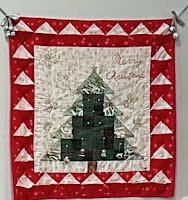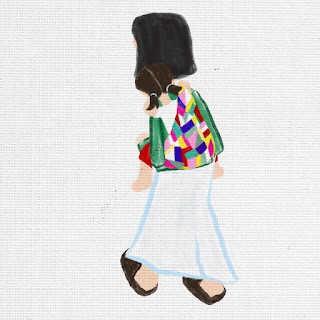Quilt and Bojagi
 (Bojagi illustrated by my daughter, Jeeho Ha)
(Bojagi illustrated by my daughter, Jeeho Ha)

When autumn knocks on the door with chilly morning air, I welcome it with fall decorations: placing ornate pumpkins in front of the entrance door, colorful mums on the front yard and inside the house, and changing the dining room tablecloth to the one with autumnal tints. This has been my ritual since I moved from Texas to Northern Virginia, where four distinctive seasons exist and, especially, lots of mature trees with exuberant fall colors paint landscape in vivid hues.
It's already mid-October. This fall, however, I haven't changed the tablecloth yet. Last fall, my younger daughter inadvertently spilled nail polish remover on the table, damaging much of the autumn tablecloth that I used for many years. The red and yellow maple pattern tablecloth had become a part of me with stains of memory. I decided to make a quilt tablecloth with it after cutting off the damaged parts.
It wasn't a small decision for me to make a quilt, as I haven't dared to try quilting again since my first try in 1999. I first learned about the American quilt in a cultural class. In Texas, where I first settled in the United States, an American church offered classes for foreigners. I made a Christmas quilt with a few classmates. On the 30” x 30” quilt, each of us sewed a snow-like white background that had a green pine tree in the center, surrounded with 24 tiny, red pockets holding Christmas ornaments. It took several months to complete it. How laborious and time-consuming the quilting was!
This time I'm prompted to fill the void, created by my older child leaving for college last month, with quilting. I bring out the sewing machine and remnant cloth, start designing, cutting, and sewing. For the first quilt of the Christmas tree, I bought small pieces of cloth already cut out for a Christmas quilt. Now, cutting the remnants, I comprehend that the American quilt and Korean bojagi are quite similar. Both employ scraps of cloth to make something useful. Those scraps are even transformed into art.
Patching small pieces of cloth one by one, I also notice differences between American quilts and bojagi. A quilt has layers of top, batting, and bottom as its back is not tidy. Bojagi can be completed with a single layer owing to the unique seams that have the raw edges trapped inside the seam. Besides, bojagi has served a variety of functions for objects small and big, ordinary and precious: from covering a food table, to draping a Confucian or Buddhist altar, wrapping or carrying objects, bedding or even royal wrapping cloths for the royal family.
I realize that the reason I like the Dutch artist Piet Mondrian has more to do with my childhood than the paintings themselves. Mondrian’s abstract geometric paintings like Composition series of balancing colors and dimensions divided by lines resemble the bojagi engrained in my childhood memory.
One of my early childhood memories is a small snack table covered under a bojagi, called 'sang-bo' (Sang means a table and Bo is a condensed version of bojagi). In Korea, a sang-bo, made of thin and colorful fabrics, was used to keep food fresh and protect food from flies as refrigerators were not common. The Korean traditional house of my childhood had an open space, called "maru" between the master bedroom and another room. In summer, the table in the maru was the first thing I noticed through the open bedroom door after a nap. Under a sang-bo, the table was always full of my favorite snacks.
On chilly days, the bedroom door stayed closed, and the table was in the bedroom's corner by the door. Not much heat reached near the door since ondol, the Korean traditional underfloor heating system, transferred heat from the opposite kitchen stove called 'agungi.' My mom put snacks and side dishes on the table to keep them fresh. On the other side of the room by the kitchen, hence the warmest spot, she left a bowl of steamed rice covered under a thick blanket to keep it warm.
My mom was constantly busy at home as a full-time homemaker, raising three children with no modern appliances. I guess she put the snacks on the table to catch my eyes after a nap. She must have thought that seeing the table would give me, her youngest child, some comfort when I woke up, even if she was not around. Where did such wisdom of mothers in the old days come from, even though they had little education? Wisdom seems proportional to love, just as a quilt's beauty is proportional to endeavor.
After finishing the centerpiece by patching small cloths of various autumn colors, I surround it with sizable pieces cut from the remnants of the damaged tablecloth. The wide tablecloth looks like a swaddling cloth from my childhood, made of a large piece of cloth and decorated with embroidery. My mom used to carry me on her back with an embroidered bojagi, called subo (‘su’ means embroidery). How warm and comforting it was when I laid my cheek on her back! I used to cry asking her for a piggyback ride even after I became too big for that.
My mom had to undergo surgery two years ago for severe back pain. I think her back pains are due to all the piggyback rides she gave me. Every time I reflect on my mom’s love, I feel sorry for my children. Unlike my mom, who has devoted her entire life to her children, my life has involved continuous struggles between pursuing my career and raising my children.
Spreading the finished tablecloth on the table, I realize how much time and effort it took. A quilt and bojagi requires lots of time and labor. Just like love. However, it gives much more than physical warmth as it holds memories. Just like love.
My fall decoration seems complete with the quilt tablecloth on the dining table. It stands as a testament to the enduring effort, much like the intricate love that has woven its way through the fabric of my life. In the autumn of my life, when my children leave my nest, I hope to work on adding more patches and beautiful embroidery for all.
(October 2017)



Comments
Post a Comment